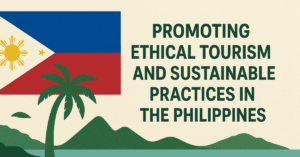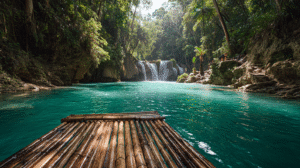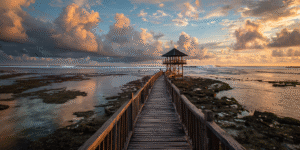Did you know El Nido isn’t just one island? It’s a protected area of 45 islands and islets scattered across the Bacuit Archipelago. This sheer scale means that while the limestone lagoons and crystalline waters are world-famous, planning a trip can feel overwhelming. The key isn’t to see everything, but to find the experiences that are right for you. With so many incredible things to do in El Nido, this guide will help you navigate the options, from the must-see tours to the quieter moments in between.
Island Hopping: The Heart of the El Nido Experience
Island hopping is the main event in El Nido, and the standardized Tours A, B, C, and D are the most common way to explore. Most tours cost around PHP 1,200–1,400 (about $20–$24 USD) per person, which includes lunch. Remember that all visitors must also pay a one-time Eco-Tourism Development Fee of PHP 200 (~$3.50 USD), valid for 10 days. Consider this your essential el nido travel guide to the famous island-hopping circuits.
- Tour A: Lagoons and Legends. This is the superstar tour, featuring the iconic Big Lagoon and Small Lagoon. Due to new regulations to manage crowds, you often have to book your lagoon slot in advance, so confirm with your tour operator. You’ll also visit Shimizu Island for snorkeling and the aptly named Secret Lagoon. Renting a kayak (around PHP 300 / $5 USD) is essential for exploring the lagoons properly.
- Tour B: Caves and Sandbars. A slightly more adventurous option, Tour B takes you to Snake Island, famous for its S-shaped sandbar that appears during low tide. You’ll also explore Cudugnon Cave, an important archaeological site, and the vast Cathedral Cave.
- Tour C: Shrines and Hidden Beaches. This tour is all about stunning beaches. You’ll visit Helicopter Island (named for its shape), Matinloc Shrine (requires a separate entrance fee of ~PHP 100), and the spectacular duo of Secret Beach and Hidden Beach—accessible only by swimming through small openings in the rock.
- Tour D: Calm Beaches and Cadlao Lagoon. Often the quietest of the four, Tour D focuses on the beautiful beaches of Cadlao Island, including Paradise Beach and Bukal Beach. It’s perfect for travelers looking to simply relax on the sand away from the larger crowds.
Insider Tip: To escape the biggest crowds, consider booking a private tour. It’s more expensive, but allows you to customize your itinerary and, more importantly, reverse the timing of the standard group tours to visit popular spots when they are less busy.
Beyond the Boat: Culture and Town Life
While nature is the main draw, the town of El Nido offers its own appeal. El Nido Town Proper is a bustling hub of guesthouses, dive shops, and restaurants. Take a walk away from the main tourist strip along the beach to see a more local side of life. For a taste of local commerce, visit the El Nido Public Market in the morning. Here you’ll see the day’s fresh catch, vibrant tropical fruits, and local vendors going about their day. It’s a grounded, authentic experience away from the polished tour operators.
Savoring Palawan: Local Food and Markets
The food in El Nido is centered on fresh, grilled seafood. Along the beach in the evening, many restaurants display the day’s catch on ice. You simply pick what you want—be it squid, parrotfish, or prawns—and they grill it for you on the spot. For a more local flavor, look for a “carinderia” (small local eatery) and try chicken adobo or kinilaw, a Filipino-style ceviche where raw fish is cured in vinegar, ginger, and onions. A meal at a beachside grill might cost PHP 500–800 ($8.50–$14 USD), while a hearty meal at a carinderia can be as low as PHP 150 ($2.50 USD).
For the Adventurous: Hikes, Dives, and More
If you’re wondering what to do in El Nido that gets your heart pumping, there are plenty of options. One of the best is climbing Taraw Cliff for a panoramic view of the bay. For safety, most travelers should opt for the Taraw Canopy Walk, which uses a secure walkway and harness system to lead you to a stunning viewpoint. The cost is around PHP 400 ($7 USD). The traditional, more extreme climb requires a guide and excellent physical condition due to sharp, jagged limestone rocks.
The waters here are also a prime destination for scuba diving, with dozens of sites catering to all skill levels. You can expect to see sea turtles, vibrant coral gardens, and schools of yellow snapper. A discovery dive for beginners typically costs around PHP 3,800 ($65 USD). For a self-guided adventure, rent a kayak from Corong-Corong Beach and paddle to nearby Papaya Beach or Seven Commandos Beach, exploring on your own schedule.
Finding Quieter Corners
While few places are truly “secret” anymore, some tourist attractions in El Nido require a bit more effort to reach, rewarding you with fewer people. A 45-minute tricycle or scooter ride north of town will take you to Nacpan Beach. This stunning, 4-kilometer stretch of cream-colored sand is perfect for a full day of swimming and relaxing. Climb the small hill at the southern end for a postcard view of its famous “twin beaches.” A round-trip tricycle ride will cost around PHP 1,000–1,500 ($17–$25 USD).
For an even more remote feel, continue north to Duli Beach, a local surf spot with a simple, laid-back vibe. Or, head inland to explore waterfalls like Nagkalit-Kalit Falls, which requires a short trek through streams and forest—a refreshing break from the sand and salt.
Essential El Nido Travel Tips
A little planning goes a long way in El Nido. The best time to visit is during the dry season from November to May. The shoulder months of November and May often provide a great balance of good weather and thinner crowds.
- Getting There: The fastest way is to fly directly to El Nido’s Lio Airport (ENI). The more common, budget-friendly route is to fly to Puerto Princesa (PPS) and take a 5-6 hour van ride.
- Money: While more establishments now accept credit cards, many smaller restaurants, shops, and all tricycles are cash-only. There are ATMs in town, but they can be unreliable. It’s wise to bring sufficient Philippine Pesos (PHP) with you.
- Connectivity: Wi-Fi in El Nido can be slow and unstable. For reliable internet, purchase a local SIM card (Globe or Smart) at the airport in Manila or Puerto Princesa.
- Be a Responsible Traveler: El Nido enforces a ban on single-use plastics. Bring a reusable water bottle and refuse plastic bags. Use reef-safe sunscreen to protect the fragile coral ecosystems that make this place so special. These small actions help preserve the beauty you came to see, making it one of the most rewarding things to do in El Nido.
El Nido is more than a checklist of beautiful places; it’s an invitation to explore. It’s about the feeling of paddling a kayak into a quiet lagoon, the taste of freshly grilled fish on the beach, and the breathtaking view after a rewarding hike. So, which part of this archipelagic wonder will you explore first?




